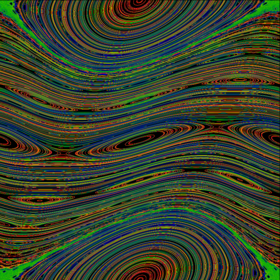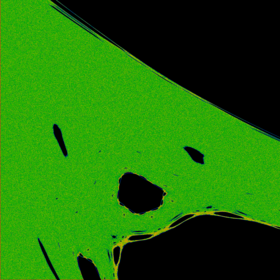- Standard map
-
The standard map is an area-preserving chaotic map from a square with side 2π onto itself. It is defined by:
- pn + 1 = pn + Ksin(θn)
- θn + 1 = θn + pn + 1
where pn and θn are taken modulo 2π.
This map is also known as the Chirikov–Taylor map or as the Chirikov standard map, The properties of chaos of the standard map were established by Boris Chirikov in 1969. See more details at Scholarpedia entry. The quantized map is also known as the kicked rotator in the quantum chaos community.
Contents
Physical model
This map describes the motion of a simple mechanical system known as the kicked rotator. It consists of a stick that is free of the gravitational force, which can rotate frictionlessly in a plane around an axis located in one of its tips, and which is periodically kicked on the other tip. The variables θn and pn respectively determine the angular position of the stick and its angular momentum after the n-th kick. The constant K measures the intensity of the kicks.
The kicked rotator approximates systems studied in the fields of mechanics of particles, accelerator physics, plasma physics, and solid state physics. For example, circular particle accelerators accelerate particles by applying periodic kicks, as they circulate in the beam tube. Thus, the structure of the beam can be approximated by the kicked rotor. However, this map is interesting from a fundamental point of view in physics and mathematics because it is a very simple model of a conservative system that displays Hamiltonian chaos. It is therefore useful to study the development of chaos in this kind of system.
Main properties
For K = 0 the map is linear and only periodic and quasiperiodic orbits are possible. When plotted in phase space (the θ–p plane), periodic orbits appear as closed curves, and quasiperiodic orbits as necklaces of closed curves whose centers lie in another larger closed curve. Which type of orbit is observed depends on the map's initial conditions.
Nonlinearity of the map increases with K, and with it the possibility to observe chaotic dynamics for appropriate initial conditions. This is illustrated in the figure, which displays a collection of different orbits allowed to the standard map for various values of K > 0. All the orbits shown are periodic or quasiperiodic, with the exception of the green one that is chaotic and develops in a large region of phase space as an apparently random set of points. Particularly remarkable is the extreme uniformity of the distribution in the chaotic region, although this can be deceptive: even within the chaotic regions, there are an infinite number of diminishingly small islands that are never visited during iteration, as shown in the close-up.
Circle map
The standard map is related to the circle map, which has a single, similar iterated equation:
- θn + 1 = θn + Ω − Ksin(θn)
as compared to
- θn + 1 = θn + pn + Ksin(θn)
- pn + 1 = θn + 1 − θn
for the standard map, the equations reordered to emphasize similarity. In essence, the circle map forces the momentum to a constant.
References
- Chirikov, B.V.. Research concerning the theory of nonlinear resonance and stochasticity. Preprint N 267, Institute of Nuclear Physics, Novosibirsk (1969) (in Russian) [Engl. Transl., CERN Trans. 71 - 40, Geneva, October (1971), Translated by A.T.Sanders]. link
- Chirikov, B.V.. A universal instability of many-dimensional oscillator systems. Phys. Rep. v.52. p.263 (1979) Elsvier, Amsterdam.
- Lichtenberg, A.J. and Lieberman, M.A. (1992). Regular and Chaotic Dynamics. Springer, Berlin. ISBN 978-0-387-97745-4. Springer link
- Ott, Edward (2002). Chaos in Dynamical Systems. Cambridge University Press New, York. ISBN 0-521-01084-5.
- Sprott, Julien Clinton (2003). Chaos and Time-Series Analysis. Oxford University Press. ISBN 0-19-850840-9.
See also
- Ushiki's theorem
External links
Categories:- Chaotic maps
Wikimedia Foundation. 2010.





